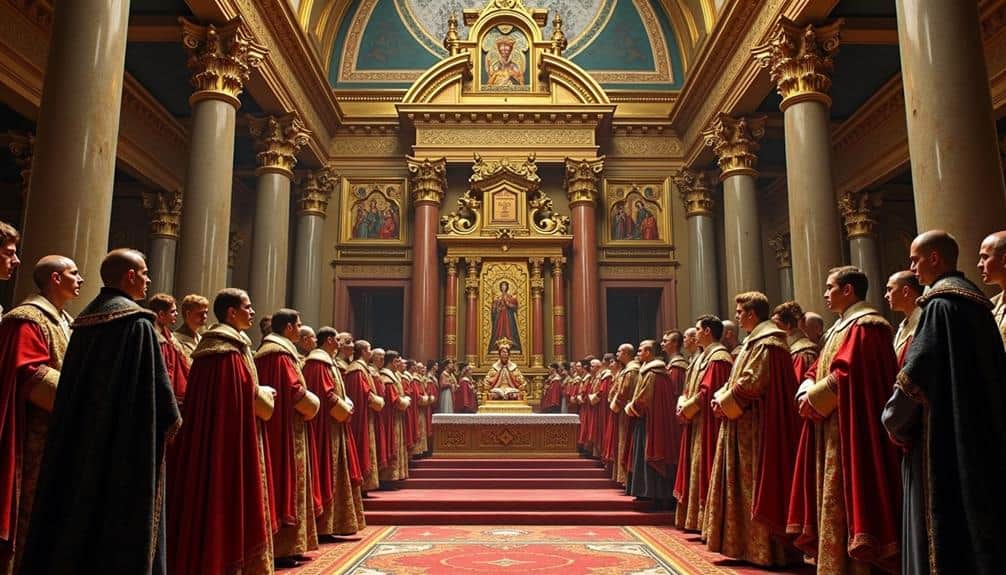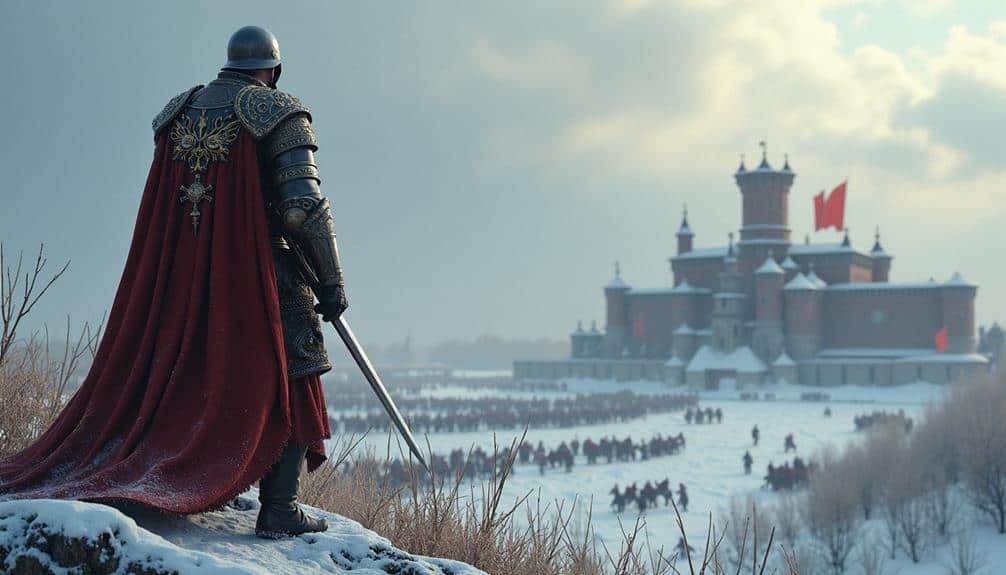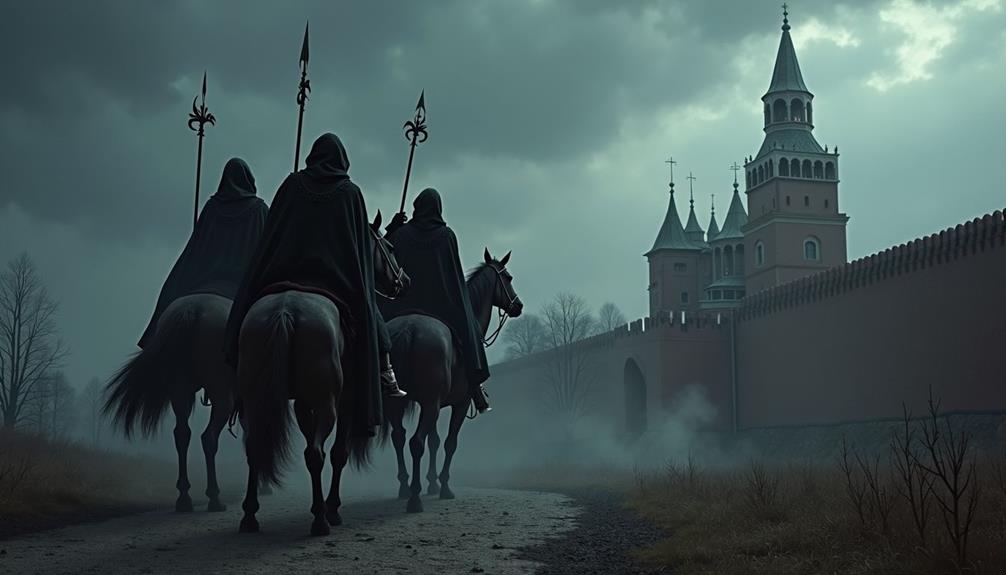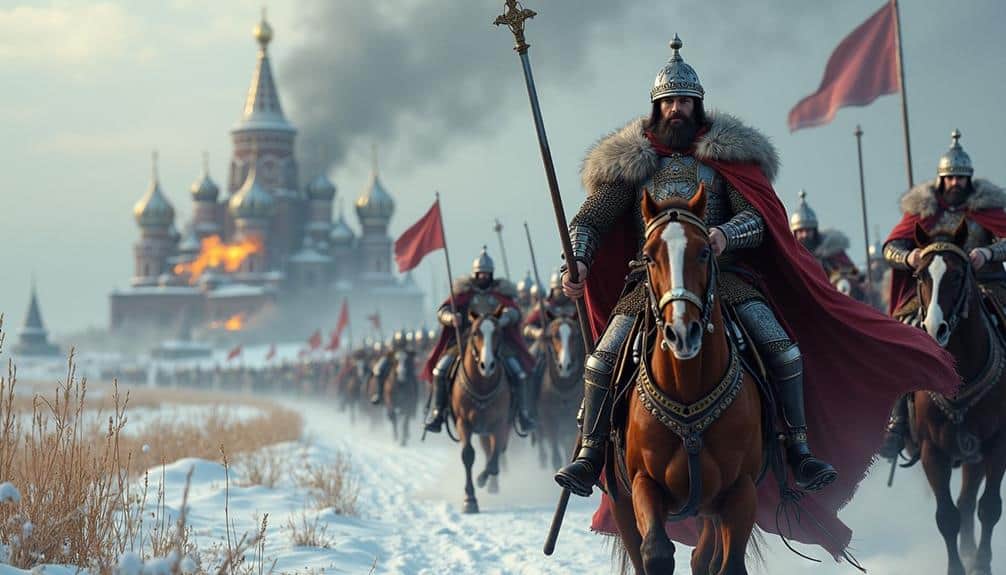Ivan the Terrible’s ascension as the first Tsar of All Russia in 1547 marked the beginning of a transformative yet tumultuous era. His reign is often remembered for its stark dichotomy: while he implemented substantial legal and administrative reforms that centralized the Russian state, his establishment of the Oprichnina introduced a period of severe repression and fear. The complexities of Ivan’s rule, from his ambitious territorial expansions to his infamous reputation for brutality, prompt a deeper examination of how one leader could embody both visionary and tyrannical qualities. What were the driving forces behind his dual legacy?
Early Life and Ascension

Born on August 25, 1530, Ivan IV Vasilyevich, who would later be known as Ivan the Terrible, was the son of Grand Prince Vasily III and Elena Glinskaya. His royal lineage traced back to the esteemed Rurik dynasty, a factor that significantly shaped his identity and ambitions from a young age.
Ivan’s early life was marked by a series of tumultuous events that profoundly influenced his psychological development and future rule. Following the death of his father in 1533, Ivan was thrust into a volatile political environment. His mother, Elena Glinskaya, served as the regent but faced intense opposition from rival boyar factions. This period of political instability exposed Ivan to the ruthless power struggles within the Russian court, leaving an indelible mark on his psyche. The constant threat and intrigue embedded a deep sense of mistrust and a need for absolute control in his young mind.
Listen to our conversational video on Ivan The Terrible
Ivan’s education upbringing was rigorous and comprehensive, befitting his royal status. He received instruction in various subjects, including theology, history, and the arts, which were instrumental in shaping his worldview. Despite his privileged education, Ivan’s formative years were marred by isolation and neglect, as he was often sidelined by the very boyars who sought to control the throne.
These childhood influences fueled Ivan’s early ambitions to consolidate power and reform the fractured political landscape of Russia. His experiences fostered a resolve to centralize authority and diminish the influence of the boyar class, setting the stage for his later, more infamous actions.
Ivan’s early life, thus, was a crucible that forged his complex and often contradictory character, marked by both visionary leadership and brutal despotism.
Coronation as Tsar

Ivan’s early experiences with political instability and his determination to consolidate power culminated in a significant milestone on January 16, 1547. On this date, Ivan IV was crowned as the first Tsar of All Russia, a title that carried profound ceremonial significance and marked a transformative moment in Russian history.
The coronation ceremony, held at the Dormition Cathedral in the Moscow Kremlin, was steeped in religious symbolism, underscoring the divine right of the ruler and the unity of the state and church.
The political implications of Ivan’s coronation were far-reaching. By adopting the title of Tsar, Ivan IV positioned himself not only as the sovereign ruler of Russia but also as the heir to the legacy of the Byzantine Empire, projecting an image of immense authority and legitimacy. This move was intended to strengthen his grip on power and to deter potential rivals.
It signaled the beginning of an autocratic rule that would redefine the Russian state’s structure, centralizing authority and diminishing the influence of the boyar aristocracy.
Public perception of Ivan’s coronation was multifaceted. For many Russians, it was a moment of national pride and a step towards stability after years of political turbulence. However, the ceremonial grandeur also conveyed an unmistakable message of Ivan’s absolute power, contributing to a climate of both reverence and fear.
In the broader historical context, Ivan’s coronation as Tsar marked the emergence of Russia as a significant power in Eastern Europe. It laid the foundations for future territorial and political expansion, setting the stage for the country’s evolution into a formidable empire.
Territorial Expansion

The reign of Ivan the Terrible saw significant territorial expansion, profoundly altering the geopolitical landscape of Eastern Europe. Ivan IV’s expansion policies were ambitious and multifaceted, characterized by a combination of military conquests and strategic alliances. His era marked a pivotal shift in the Russian state’s approach to territorial acquisition, laying the groundwork for the vast Russian Empire.
One of the most notable achievements of Ivan’s expansionist agenda was the conquest of the Khanates of Kazan (1552) and Astrakhan (1556). These victories were not merely military triumphs but strategic moves designed to secure Russia’s eastern borders and open up the Volga River for trade. The successful subjugation of these regions was achieved through innovative military tactics and a well-organized army, which included the utilization of newly acquired artillery technology.
Territorial conflicts with neighboring states were a constant during Ivan’s reign. His campaigns in Livonia, aimed at gaining access to the Baltic Sea, embroiled Russia in prolonged wars with Sweden, Poland, and the Livonian Order. These conflicts, part of what came to be known as the Livonian War (1558-1583), showcased both the strengths and limitations of Ivan’s military strategies. Despite initial successes, the protracted warfare strained Russia’s resources and exposed vulnerabilities in its border security.
Strategic alliances played a crucial role in Ivan’s territorial ambitions. By forging temporary alliances with various regional powers, Ivan aimed to isolate his adversaries and consolidate Russian gains. However, these alliances were often fragile and subject to the shifting dynamics of regional politics.
Legal and Administrative Reforms

While territorial expansion defined much of Ivan the Terrible’s reign, his domestic policies, particularly in legal and administrative reforms, were equally transformative. Central to these changes was the reform implementation aimed at modernizing the governance of his vast empire.
Ivan’s reign saw significant strides in legal codification, most notably through the Sudebnik of 1550, which revised and expanded the existing legal code. This codification process aimed to standardize laws across the Tsardom of Russia, thereby reducing regional disparities and enhancing judicial consistency.
Administrative centralization was another hallmark of Ivan’s reforms. By consolidating power within the central government, Ivan sought to diminish the influence of local nobility and regional authorities. This centralization process included the creation of new administrative bodies, such as the prikazy (government departments), which streamlined state functions and improved bureaucratic efficiency. These bodies were instrumental in implementing Ivan’s policies and ensuring uniformity in administrative practices throughout the realm.
Tax restructuring also played a critical role in Ivan’s domestic agenda. To stabilize state finances and fund his ambitious projects, Ivan introduced a more systematic and equitable tax system. This restructuring aimed to alleviate the burden on peasants while ensuring a steady revenue stream for the state.
The revised tax system included land surveys to assess the taxable value of properties accurately, thereby preventing tax evasion and ensuring fairness.
Judiciary changes under Ivan the Terrible further enhanced the legal framework. He sought to professionalize the judiciary by appointing more qualified judges and establishing clearer procedures for legal proceedings. These changes aimed to reduce corruption and increase the efficiency of the judicial system, thus strengthening the rule of law across his empire.
The Oprichnina

What drove Ivan the Terrible to establish the Oprichnina, a policy that would become one of the most controversial aspects of his reign? The political landscape of 16th-century Russia was fraught with intrigue and power struggles, particularly involving the boyar nobility. Ivan IV saw the traditional aristocracy as a threat to his centralized authority. This perception led him to implement the Oprichnina, a series of policies aimed at consolidating his power and suppressing potential insurrections.
The Oprichnina policies included the establishment of a separate territory directly controlled by the Tsar. Ivan carved out this land from the existing domains, leading to significant land redistribution. Nobles who had previously held sway over these regions were either expelled or executed, thereby eliminating their influence and reasserting the Tsar’s dominance. The confiscated lands were then granted to loyal supporters, creating a new class of nobility beholden to Ivan.
Integral to the Oprichnina was the formation of the secret police, known as the Oprichniki. This paramilitary force was tasked with enforcing Ivan’s directives, often through brutal means. The Oprichniki operated with impunity, targeting the nobility and perceived enemies of the state. Their actions included public executions, torture, and widespread terror, which had a profound social impact. The fear they instilled helped to stifle dissent and reinforce Ivan’s autocratic rule.
The social impact of the Oprichnina extended beyond the nobility. Commoners, too, were affected by the constant state of fear and the economic disruptions caused by land redistribution.
While Ivan achieved his goal of nobility suppression, the long-term consequences of these measures contributed to widespread instability and hardship for the Russian populace.
Military Campaigns

Ivan the Terrible’s internal policies, such as the Oprichnina, were paralleled by his ambitious and often ruthless military campaigns. His reign was marked by a series of aggressive expansions aimed at consolidating and extending the Russian state. One of Ivan’s primary objectives was to reclaim territories lost to the Mongol invasions, which had left a lasting scar on the Russian psyche and landscape.
To achieve this, Ivan employed a variety of military strategies that showcased his tactical ingenuity and brutal determination. Ivan’s army was characterized by its effective use of siege warfare, a method that allowed him to capture heavily fortified cities and strongholds. His campaigns against the Kazan and Astrakhan Khanates are notable examples, where his forces employed sophisticated siege techniques, including the use of artillery and engineering corps to breach enemy defenses.
These victories significantly expanded Muscovy’s territory and influence, consolidating Ivan’s power. Cavalry tactics played a crucial role in Ivan’s military successes. The Russian cavalry, including the elite Streltsy units, were instrumental in both offensive and defensive operations. Their mobility and combat skills allowed Ivan to execute rapid strikes against enemy forces and to defend against incursions from hostile neighbors.
Furthermore, Ivan was adept at navigating the complex web of enemy alliances. He often exploited divisions among his adversaries, forming temporary alliances with some to defeat others. This diplomatic maneuvering was particularly evident in his campaigns against the Livonian Order, where he capitalized on internal strife to gain an advantage.
Personal Life and Tragedies

Often shrouded in both legend and historical ambiguity, the personal life of Ivan the Terrible was marked by profound tragedies and turbulent relationships that shaped his complex character. Ivan IV Vasilyevich, born in 1530, experienced significant childhood trauma following the death of his father, Vasili III, when he was just three years old. His mother, Elena Glinskaya, served as regent but died mysteriously when Ivan was eight, leading to a power struggle among the boyars, the Russian nobility.
This early exposure to treachery and instability profoundly influenced Ivan’s psyche, fostering a deep-seated mistrust and emotional turmoil that would persist throughout his life.
Ivan’s family dynamics further complicated his personal life. His first marriage to Anastasia Romanovna in 1547 was a rare source of solace and stability. However, her sudden death in 1560, speculated to be poisoning by the boyars, plunged Ivan into a period of intense grief and paranoia.
His subsequent marriages—he had seven wives in total—were riddled with marital struggles, marked by accusations of infidelity and abuse, reflecting his growing instability.
Parental influence also played a crucial role in shaping Ivan’s emotional landscape. The absence of a stable parental figure, coupled with the chaotic environment of his upbringing, contributed to his volatile nature.
This instability was further exacerbated by the death of his eldest son, Ivan Ivanovich, in a tragic altercation with Ivan himself in 1581, a moment often cited as a pinnacle of his life’s emotional turmoil.
Legacy and Cultural Impact

While Ivan the Terrible’s reign was marked by brutality and psychological turmoil, his legacy and cultural impact on Russia remain profound and multifaceted. As the first Tsar of Russia, Ivan IV’s political legacy is significant; he centralized power, laying the groundwork for the autocratic governance that would define Russian rule for centuries. His reign saw the establishment of the Oprichnina, a state policy that reinforced the Tsar’s absolute authority, influencing the future trajectory of Russian political structures.
Ivan’s religious impact was equally notable. He was a fervent Orthodox Christian, who saw himself as a divine ruler appointed by God. This belief reinforced the idea of the Tsar as both a political and spiritual leader, a notion that would persist in Russian society and governance. The construction of St. Basil’s Cathedral, a masterpiece of Russian architecture, stands as a lasting testament to his religious devotion and artistic influence.
In terms of cultural symbolism, Ivan the Terrible embodies the duality of Russian leadership—feared for his cruelty but revered for his strength. This paradoxical image has permeated Russian historical perception, influencing literature, art, and folklore. His complex persona has inspired countless works, from operas to films, making him an enduring figure in Russian cultural consciousness.
The historical perception of Ivan the Terrible is thus one of a ruler whose actions were as transformative as they were terrifying. His legacy is a tapestry woven with threads of despotism and devotion, power and paranoia, which continue to shape Russia’s national identity and cultural heritage.




